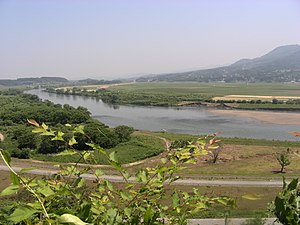Hiraizumi (Iwate)
| Hiraizumi-chō 平泉 町 |
||
|---|---|---|
| Geographical location in Japan | ||
|
|
||
| Region : | Tōhoku | |
| Prefecture : | Iwate | |
| Coordinates : | 38 ° 59 ' N , 141 ° 7' E | |
| Basic data | ||
| Surface: | 63.39 km² | |
| Residents : | 7389 (October 1, 2019) |
|
| Population density : | 117 inhabitants per km² | |
| Community key : | 03402-9 | |
| Symbols | ||
| Flag / coat of arms: | ||
| Tree : | Crescent fir | |
| Flower : | Cherry Blossom | |
| Bird : | Japanese Bush Warbler | |
| town hall | ||
| Address : |
Hiraizumi Town Hall 45 - 2 , Aza Shirayama, Hiraizumi Hiraizumi -chō, Nishiiwai-gun Iwate 029-4192 |
|
| Website URL: | http://www.town.hiraizumi.iwate.jp | |
| Location of Hiraizumis in Iwate Prefecture | ||
Hiraizumi ( Japanese 平泉 町 , - chō ) is a city in Nishiiwai County in Iwate Prefecture in Japan .
history
The Ōshū - Fujiwara had been one of the most powerful families in Japan since the middle of the seventh century. They ruled the Tōhoku region (northern Japan) around 1000-1200 and chose the city of Hiraizumi as their residence, from where they could rule relatively undisturbed by the central power in Heian-kyō . Due to its proximity to the holy mountain Kanzan, Hiraizumi was already considered the religious center of the region and was strategically located.
The city flourished soon after the election. Archaeological excavations in the late 1980s / early 1990s uncovered the remains of a large castle, probably the residence of the third prince of Hiraizumi, as well as many temples. There were also many clay bowls called kawarake and even Chinese porcelain , more than anywhere else in Japan, except in Kyoto and Hakata . At that time, Hiraizumi had a population of 100,000-150,000 people, making it one of the largest cities in Japan. For comparison: in Japan there were around 10 million people at that time and 160,000–300,000 in the capital Heian-kyō.
The city owes its great wealth to lively trade relations with the rest of Japan and also in the north, with the Ainu on Hokkaidō and even as far as Sakhalin and the nearby mainland. Sea lion and bear skins, gold - soaps and seaweed were purchased from Hokkaidō . However, trade also brought great cultural changes for the Ainu, because they gave up their own pottery art through the iron pots they imported.
The city of Hiraizumi went under together with the Fujiwara family in 1189. Only the most important temples remained, the rest of the city was razed to the ground. The trade relations, however, continued even after the fall of Hiraizumi. Today there is only this community of the same name from the then Hiraizumi aside from the temples.
In June 2011, the temples, gardens and archaeological sites were designated a World Heritage Site by UNESCO .
Attractions
Although many former palaces fell into disrepair over time, Hiraizumi is still home to some important architectural treasures of Japan, including many Buddhist temples . The best known is the Chūson-ji ( 中 尊 寺 ) in the mountains with the mausoleum of Ōshū Fujiwara, the magnificent Golden Hall ( 金色 堂 , Konjikidō ) made of gold leaf and mother-of-pearl .
Below in Hiraizumi is the lake of the former temple of the Fujiwara , built in the style of the Heian period . On the south side is the Mōtsū-ji ( 毛 越 寺 ).
The Geibiki Gorge with the Satetsu River is attractive in terms of landscape .
Neighboring cities and communities
Individual evidence
- ↑ unesco.org: New Inscribed Properties - 2011 (accessed June 26, 2011).







